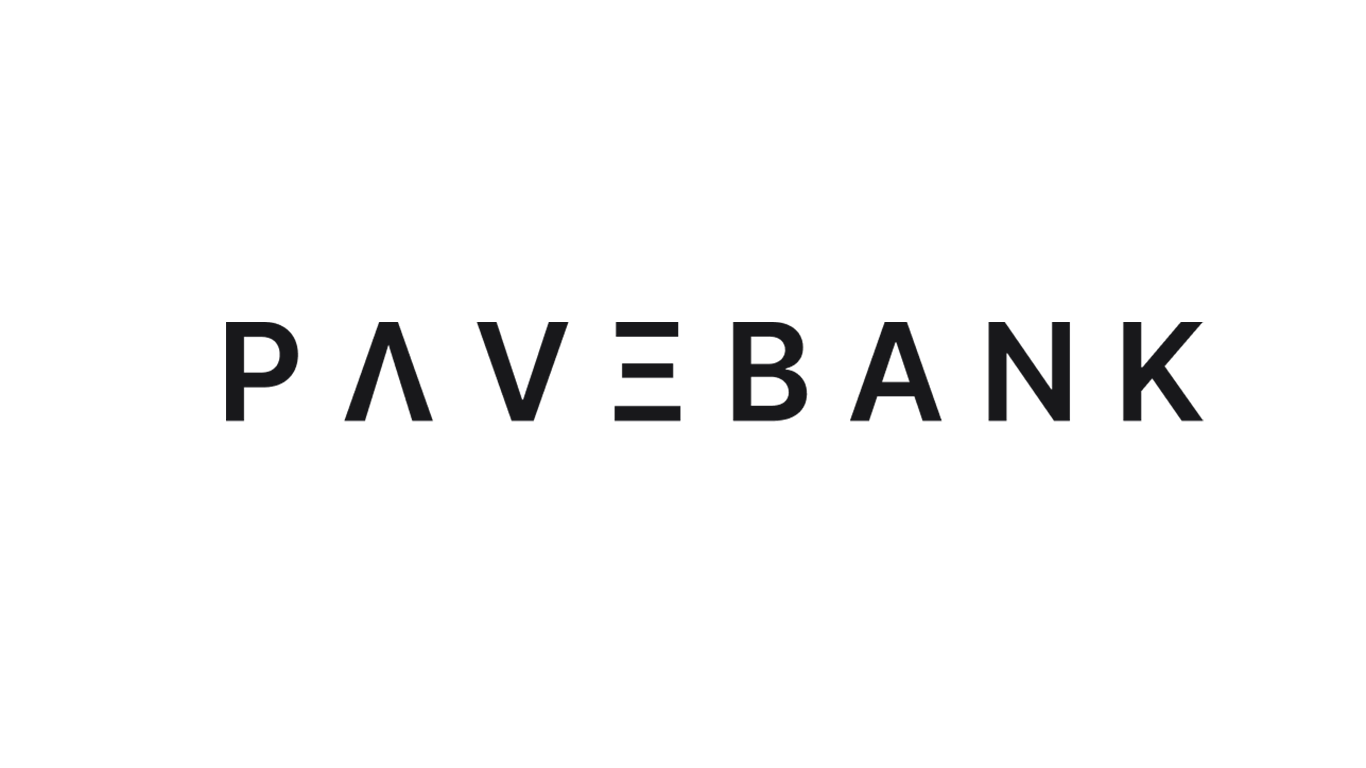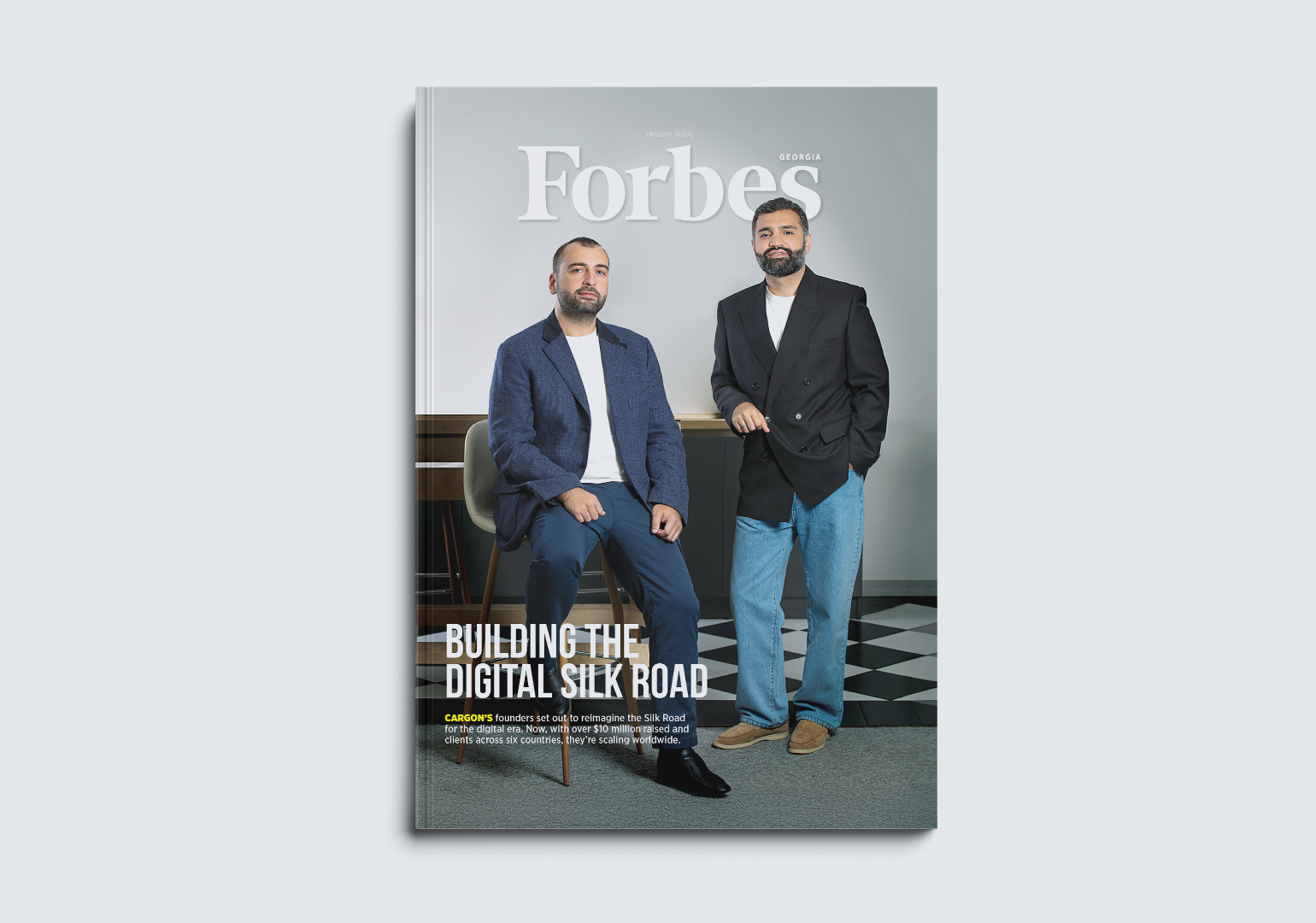This is for y’all one-person marketing “teams” and founders out there. I feel you and this is my attempt to help.
Disclaimer: I’ll be heavily borrowing from my favorite marketers and newsletters: Elena Verna, Leah Tharin, MKT1, Kyle Poyar, Lenny Rachitsky, Julian Shapiro, April Dunford, Kevin Indig, Reforge, Demand Curve.
Part 2: Marketing Assets & Advertising Engine
When you’re done with the first draft of your positioning statement it’s time to create some assets to communicate it.
In this part of the handbook let’s talk about marketing assets and advertising engine. We’ll be answering questions like:
- How do I write value propositions?
- Which assets do I need to create to get started?
- What advertising channels exist out there?
- How do I choose which channels to use for paid media?
The Only Marketing Assets You Need
This is going to be the recurring theme throughout this article – do not overcomplicate. It’s a trap.
The only assets you need in the beginning to start running experiments are:
- Value Props
- Ad Copies
- Ad Creatives
- A Landing Page
- A Sign-up Page
- Product Onboarding
This is of course assuming that your product works.
Value Props
For all these you first need value propositions. I’m going to use Julian Shapiro’s framework and examples.
Here’s an exercise for finding your product’s value props:
- What bad alternative do people resort to when they lack your product?
- How is your product better than that bad alternative?
- Now turn the last step into an action statement—that’s your value prop.
A few examples:
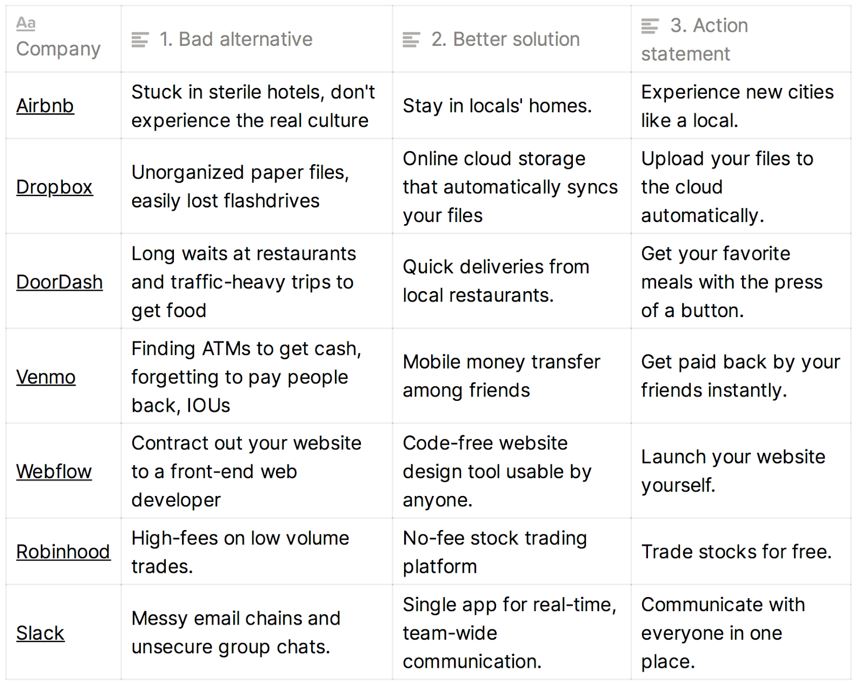
Now you take these value props and do some copywriting.
Ad Copies & Creatives
Ads are one of the most effective ways to find new customers and connect with people already familiar with your company. But there’s a big hurdle you have to overcome if you want to make money off your ads: user intent.
Someone on Facebook is not actively searching for a product or service. It’s not like Google, where they want to find results related to their search.
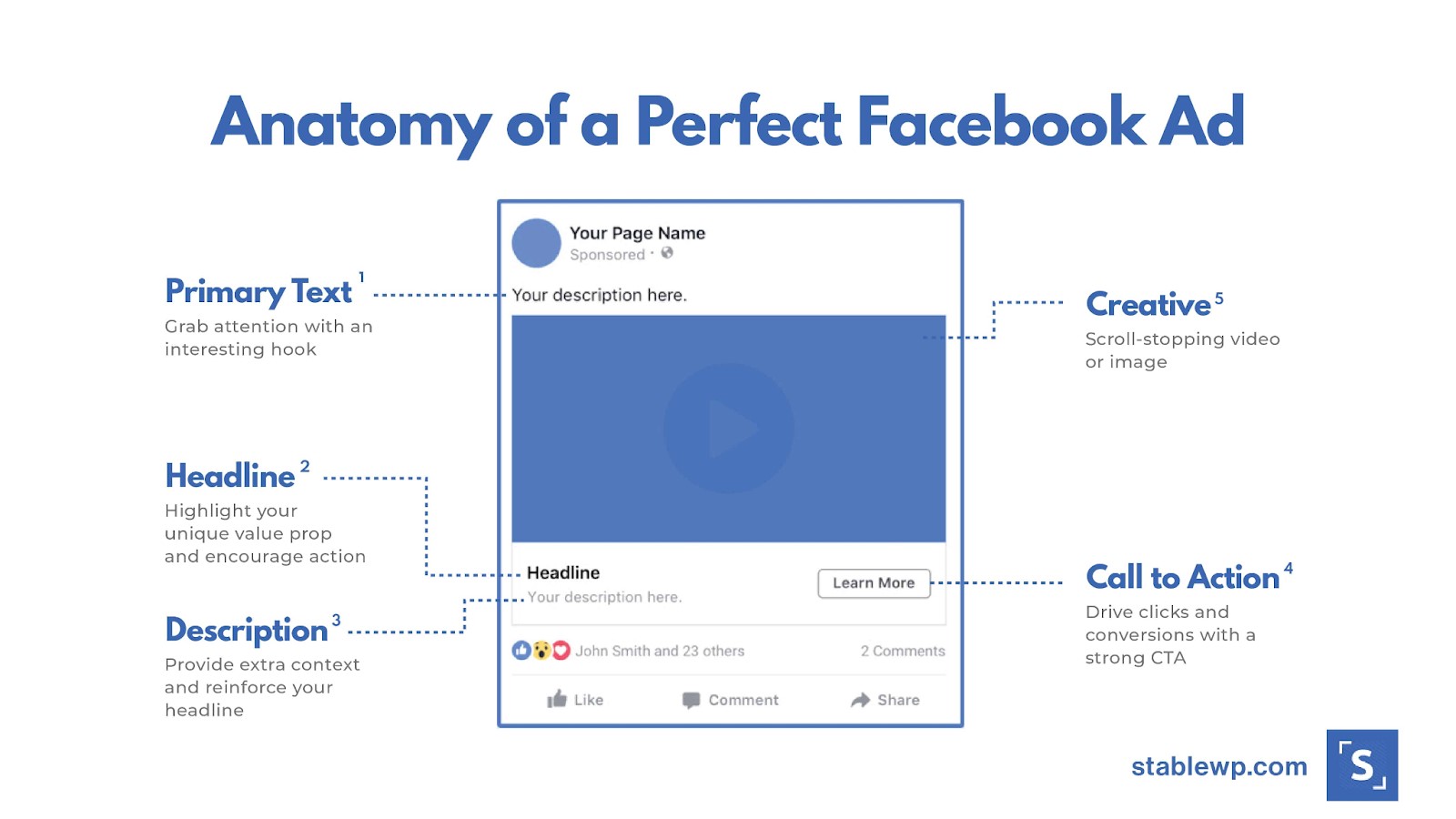
That’s why ad copies are important. Here I will be quoting from Demand Curve.
Headline copy
A few specific formulas that work best for headline copy:
- A headline that focuses on the target audience’s biggest anxieties (pull these from the problem and implication sections of your value props sheet).
- A headline that focuses on the solution and benefits of your product.
- A straightforward description of the product itself.
- A headline that focuses on social proof: ratings, press, famous customers, testimonials, etc.
Here are a few formatting and word tips:
- Keep the headline to 50 characters or less.
- If the headline is one sentence, don’t end it with a period.
- If it’s two sentences or more, use periods.
- We’ve found headlines that use “the only … in the world”, as in “the only organic dog food in the world”, convert particularly well.
Body copy
Each ‘block’ in your ad template has three length options:
- Short body copy variations: (150 characters and less)
- Medium body copy variations: (150 – (roughly) 250 characters)
- Long body copy variations: (250+ characters)
You might think short copy outperforms the others. But our data tells us otherwise. That’s why it’s a good idea to come up with at least a couple of variations for each body length.
The more you test, the more you’ll know.
By the way, when you do come up with long body copy variations, it’s best to follow this formula:
- Hook
- Product/service explanation
- Handle objections
- Write in a CTA
Creative Copy
The creative part of your ad (the image, graphic, or video) is the first element of your ad that people see in their feed. Most channels, including Facebook’s and Twitter’s, provide space for both copy and creative.
Your creative need to do just one thing:
- Depict the product in action.
- If you’re selling software, show a decluttered screenshot of the dashboard instead of an abstract vector illustration of your services.
- If you’re selling services, show the service in action, e.g. a dog walker walking a dog instead of an image of a dog next to a leash.
That’s it. Do not overcomplicate.
Just remember – video ads usually outperform static visual ads simply because they display products in action better.
And you don’t need a designer to create these visuals. Here are some tools instead:
- Sketch or Canva – Lightweight drag-and-drop design tools.
- Unsplash – High-quality and natural-looking free photos.
- Animoto – Create affordable videos at scale.
Building an Effective Landing Page
Your website is your #1 most important marketing asset.
When your homepage content and copy miss the mark, your conversion rate suffers, and all of your top-of-funnel efforts are wasteful.
This is the landing page framework I swear by, designed by Emily Kramer:
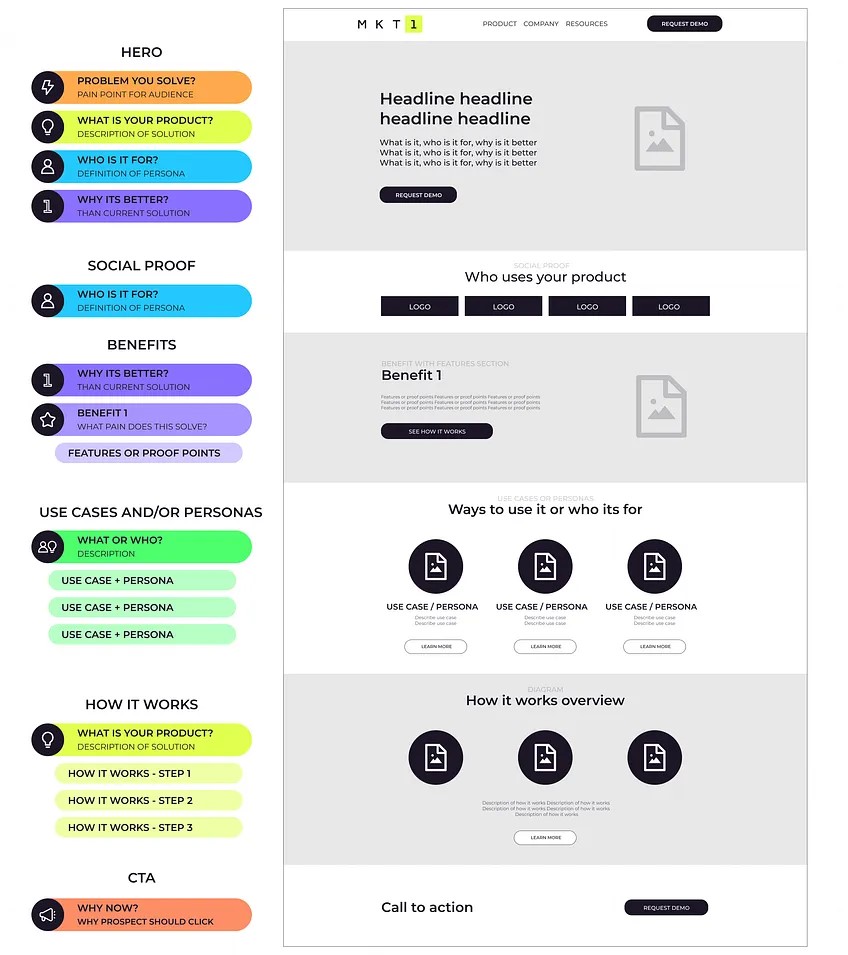
Everything is on the visual, so zoom in.
Here are some additional tips:
- Don’t model your website after a late-stage company: If you are an early or growth-stage startup, don’t look at Stripe or Notion’s website. People know what Stripe and Notion are. They don’t know you.
- Communicate your product, not your vision: Users don’t care about your vision (investors do). What users care about is whether or not this is the product they need. Again – product-led.
- Be clear about who you’re talking to: Be realistic. Your budget is limited. You can only reach so many people. Be picky with who you target.
- Copy is only half the battle: You need design and images to augment the words on the page. Do NOT use stock photos.
The tools I’d recommend to build a landing page:
- Webflow – for a full-blown professional website with a blog.
- Carrd – for a one-page simple website. This is as simple as it gets.
Recommended Articles
- How to create a more effective homepage – MKT1
- Your website is your most important marketing asset – MKT1
- Startup Handbook: Landing Page Copywriting – Julian Shapiro
- How to write your landing page – Demand Curve
Sign-up Page and Onboarding
Most SaaS apps lose 95% of their new users after 90 days. That’s insane.
When you lose a user’s interest on the sign-up page or during onboarding, your first impression is complete, and they typically never return.
When you onboard users, you want to welcome them into your product in a way that excites them to become lifelong customers.
You can do this multiple ways:
- Integrated walkthrough – Walk the user through one product feature at a time while having them fill out their profile or create a sample project in the process.
- Sample data and tooltips – Or you can throw them right into their account. If you do this, present them with pre-filled sample data to play with in places where they’re expected to enter their own input.
- Video – only if you can easily visualize your product’s value — or if you have a very complex product that requires intricate explanation — make users watch an optional screen recording video.
These are the principles of onboarding design:
- Decrease friction (remove obstacles)
- Make it enticing
- Make it productive
One last thing to remember is that the onboarding doesn’t start after signing up. It starts when they see the ad. That’s why the road from the ad → to the landing page → to the sign-up page → to the product onboarding – needs to be smooth and productive.
Recommended Articles
- How to do user onboarding – Julian Shapiro
- Outcome-Based Onboarding for Users vs. Customers – Reforge
- Your guide to product-led onboarding – Kyle Poyar
- Your guide to self-serve onboarding – Kyle Poyar
- Mastering onboarding – Lenny’s Newsletter
Product-led Advertising
People don’t like ads. There, I said it.
But here’s the irony – done right, they can’t resist clicking.
You’re going to need all the assets you created in the previous chapter. That goes for all the channels over here. But which channels?
Google Search · Instagram · Facebook · Quora · Amazon · Google Display · App Store · Pinterest · YouTube · Bing · LinkedIn · Affiliates · Influencers · Email · Physical ads · TV · Print · Radio · Community
Basically, whichever happens to cost-effectively scale for your startup. Nobody can tell you for sure what will work for you but here are some of the experiments I would prioritize based on your business type:
For B2C
- B2C eCommerce: Instagram/FB, influencers, sponsorships, and marketplaces should be your playground. You might also try dipping your toes into Pinterest, Google Ads, and Google Shopping.
- B2C Mobile Apps: Your best bets? Instagram/FB Ads, Google Ads and Apple Search. Maybe a bit of good old referrals.
- B2C SaaS: Facebook Ads, content-driven strategies, and product-led growth should be your mantra. And don’t be shy to play with Google Ads and collaborative partnerships.
- Brick and Mortar: Traditional, but evergreen. Try Facebook Ads, Instagram Ads, Banners, and a bit of PR magic. Maybe even Google Ads, and affiliate program.
For B2B
- Niche B2B with high ARPU: Think enterprise software charging big bucks annually. Sales, content, webinars, partnerships, Facebook Ads, Google Ads, and LinkedIn Ads will be your allies for lead generation.
- Broad B2B with medium ARPU: Imagine software for small businesses, say, accounting tools. The tactics from the previous point largely apply. The only twist: a bit more focus on ads and content and a bit less on sales, webinars and partnerships.
- Niche B2B with low ARPU: Say, a specialized tool for app developers. With limited ad and sales budgets, your best shots are word-of-mouth, communities, product-led growth, and genuine content.
- Broad B2B with low ARPU: General software products that don’t break the bank. Content Marketing, Google Ads, and perhaps Apple Search Ads if you’ve got an app in the mix. Mass distribution partnerships and integrations could be the cherry on top.
*ARPU – average revenue per user
Use ICE Framework to Choose
So, you’re gearing up to test the waters. But a word of caution – don’t dive in head-first without a strategy. Sean Ellis’s ICE prioritization framework is your compass here. Rank each channel using the ICE method:
- Impact (1-10): How game-changing would the channel be if it hits the bullseye?
- Confidence (1-10): How sure are you about its potential?
- Ease (1-10): How effortless is the trial?
Armed with this, you’re not just throwing darts in the dark. You’re aiming with precision.
That’s it for marketing assets and advertising engine. The next part will focus on content and SEO.
Recommended Articles
- Startup Handbook: Product-Led Acquisition – Julian Shapiro
- Startup Handbook: Customer Acquisition Channels – Julian Shapiro
- How to measure a product marketing strategy – 10 KPIs to track – Pdocut Marketing Alliance
- Digital Advertising in 2022 – Ben Thompson
- The (marketing) funnel isn’t dead – MKT1

Misho Zghuladze
Co-founder & Growth Lead at Kernel


